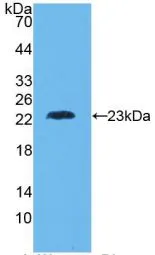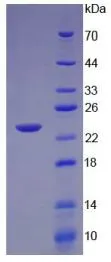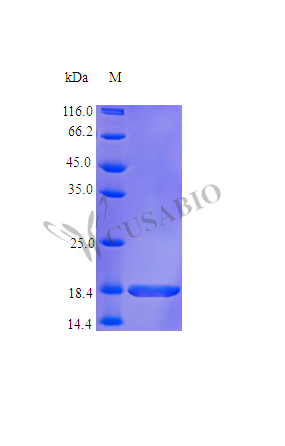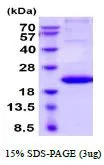
WB analysis of GTX00103-pro Human TNF beta protein (active).
Human TNF beta protein, His tag (active)
GTX00103-PRO
ApplicationsFunctional Assay
Product group Proteins / Signaling Molecules
Protein IDP01374
Overview
- SupplierGeneTex
- Product NameHuman TNF beta protein (active)
- Delivery Days Customer9
- Application Supplier NoteTNF-beta, a member of the tumor necrosis factor family, is a potent lymphoid factor that exerts cytotoxic effects on a wide range of tumor cells. The biological effects of TNF-beta are very similar to TNF-alpha, due to the similarity of molecular structure and the receptors. As reported, TNF-beta could inhibit the proliferation and induce necrosis of A549 cells, and the concentration of IL-1beta in cell supernatant will increase after stimulation. Therefore, A549 cells were incubated in DMEM with TNF-beta (10 ng/ml) for 8h, 24h, 48h, 72h, then cells were observed by inverted microscope.
- ApplicationsFunctional Assay
- CertificationResearch Use Only
- ConjugateUnconjugated
- Protein IDP01374
- Protein NameLymphotoxin-alpha
- Scientific DescriptionThe encoded protein, a member of the tumor necrosis factor family, is a cytokine produced by lymphocytes. The protein is highly inducible, secreted, and forms heterotrimers with lymphotoxin-beta which anchor lymphotoxin-alpha to the cell surface. This protein also mediates a large variety of inflammatory, immunostimulatory, and antiviral responses, is involved in the formation of secondary lymphoid organs during development and plays a role in apoptosis. Genetic variations in this gene are associated with susceptibility to leprosy type 4, myocardial infarction, non-Hodgkins lymphoma, and psoriatic arthritis. Alternatively spliced transcript variants have been observed for this gene. [provided by RefSeq, Jul 2012]
- Storage Instruction-20°C or -80°C,2°C to 8°C
- UNSPSC12352202









